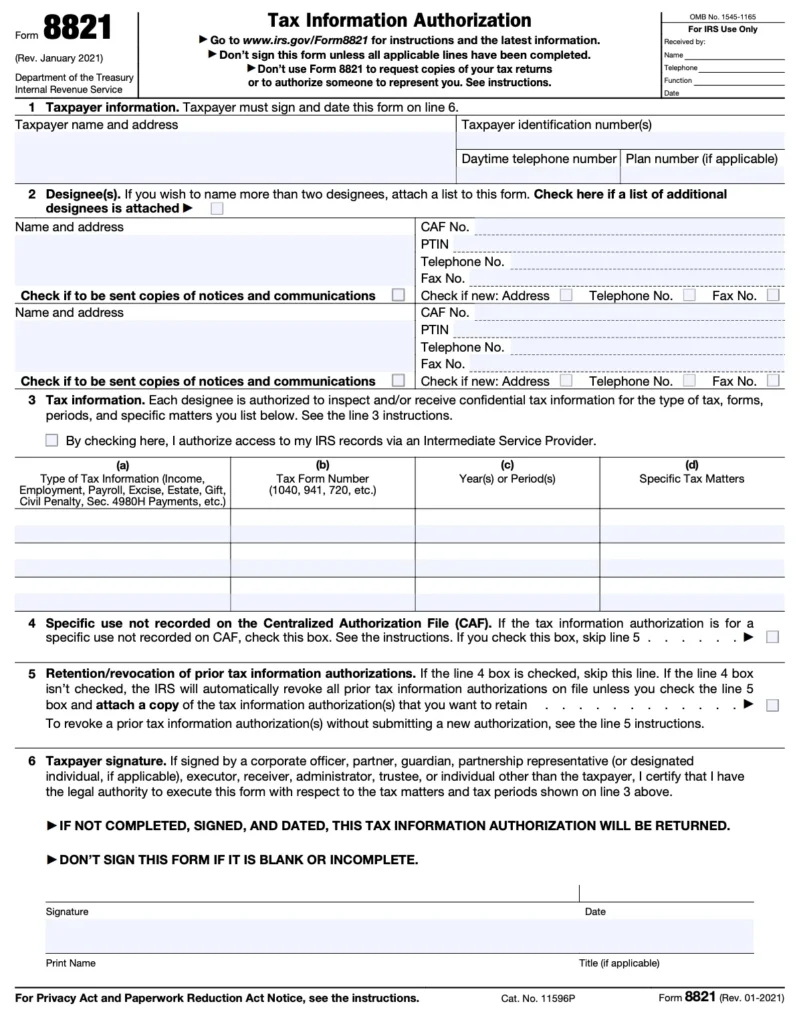IRS Form 8821 (Tax Information Authorization) allows taxpayers to designate individuals or organizations to:
- Receive confidential tax information
- Review account details with the IRS
- Access transcripts and records
- Receive copies of IRS notices
Table of Contents
When Should You File Form 8821?
Consider filing if you need to:
- Authorize a tax professional to inquire about your account
- Grant access to financial institutions for loan applications
- Allow family members to handle tax matters
- Designate a representative during audits or disputes
- Share information with legal or financial advisors
Important: This form doesn’t authorize representation before the IRS. Professional tax services can advise if you need Form 2848 instead.

Step-by-Step Guide to Completing Form 8821
Step 1: Identify Your Designee
Choose an authorized recipient with the following:
- Valid SSN, EIN, or PTIN
- There is a clear need for your tax information
- Professional credentials (if applicable)
Step 2: Gather the Required Information
Prepare:
- Your personal information (SSN, address)
- Designee’s details (name, contact information)
- Specific tax matters needing authorization
- Relevant years/forms to be accessed
- Any financial statements related to the authorization
Step 3: Complete Section I – Taxpayer Information
- Line 1a: Your full legal name
- Line 1b: Your SSN, EIN, or other taxpayer ID
- Line 1c: Your current address
- Line 1d: Your daytime phone number

Step 4: Complete Section II – Designee Information
- Line 2a: Designee’s name/firm
- Line 2b: Designee’s CAF number (if applicable)
- Line 2c: Designee’s contact information
- Line 2d: Designee’s relationship to you
Step 5: Complete Section III – Authorization Details
- Line 3: Tax form numbers (1040, 1120, etc.)
- Line 4: Specific tax matters (if limited scope)
- Line 5: Years/periods covered
- Line 6: Special limitations or restrictions
Step 6: Complete Section IV – Signature
- Line 7: Your signature and date
- Line 8: Notary section (if required by state)
Step 7: Submit the Form
- File by mail or fax to the appropriate IRS office
- Keep copies for your records
- Allow 2-4 weeks for processing
- Verify acceptance through the IRS CAF system
Common Mistakes to Avoid
- Incomplete designee information – Missing CAF numbers delay processing
- Very broad authorizations – Specify exact matters and years
- Missing taxpayer signature – Invalidates the authorization
- Expired authorizations – Typically valid until revoked
- Failing to update for new matters – Requires new forms for additional issues
For complex authorization needs, professional tax services ensure proper documentation.
Advanced Considerations
Documentation Requirements
- Supporting financial statements for specific matters
- Additional forms for certain authorization types
- State-level information release requirements
- Record retention policies
Authorization Scope
- Transcript access limitations
- Notice copy provisions
- Third-party designee rules
- Confidentiality restrictions
Multiple Authorizations
- Primary designee designation
- Team access considerations
- Conflict of interest prevention
- Communication protocols

Final Thoughts
Proper completion of IRS Form 8821 is essential for taxpayers who need to authorize third-party access to their tax information. By carefully selecting qualified designees, specifying the exact authorization scope, and maintaining proper documentation, including relevant financial statements, you can ensure efficient information sharing with the IRS. For individuals with complex tax situations, ongoing representation needs, or sensitive financial matters, partnering with professional tax services provides the expertise needed to manage these authorizations effectively.










